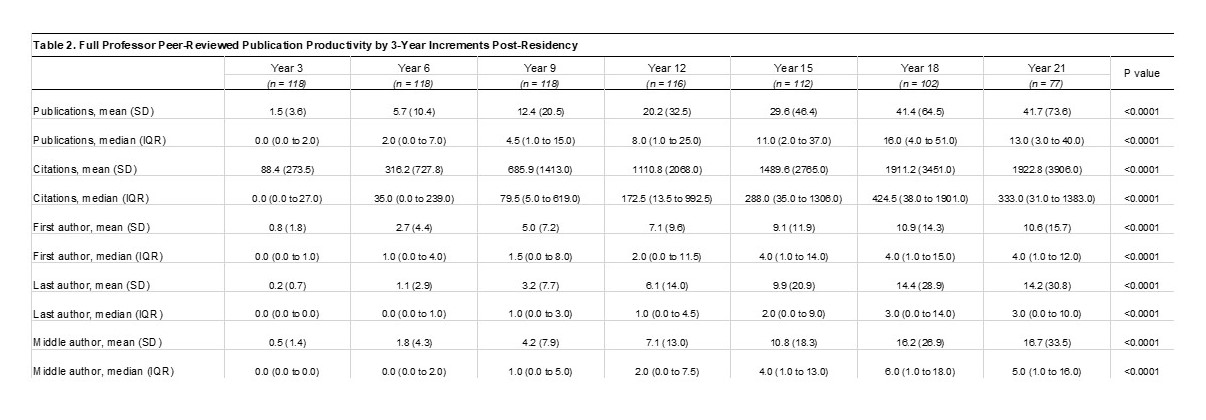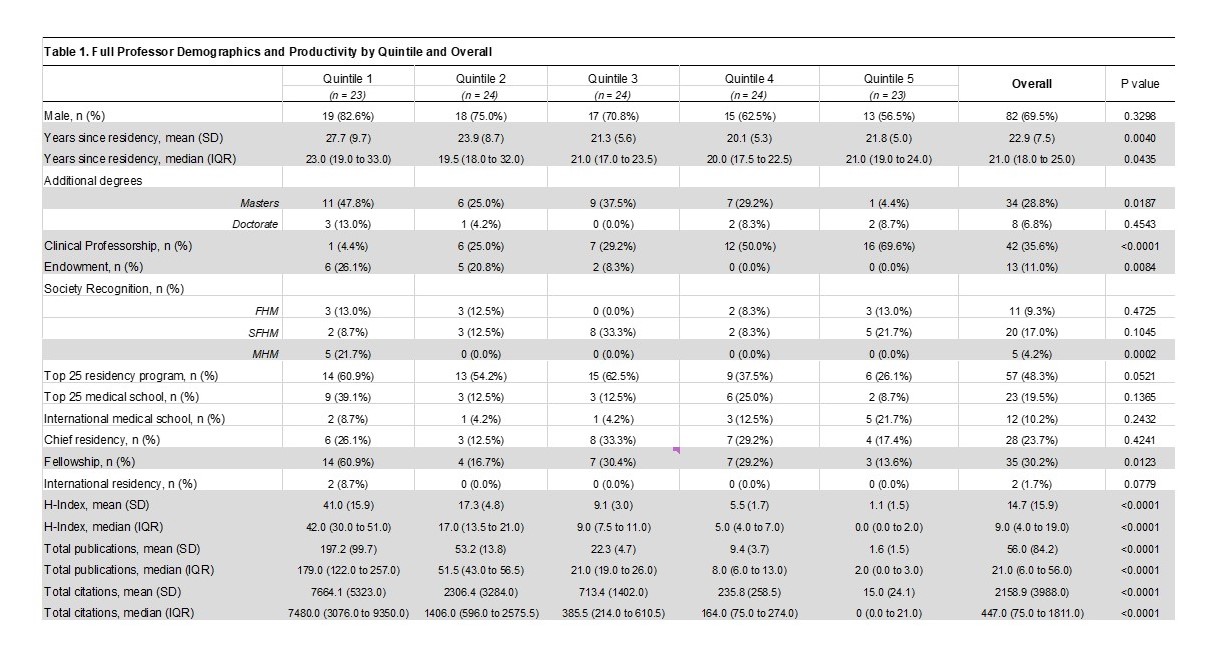Background: While academic hospital medicine (HM) has experienced rapid growth, criteria for promotion, especially regarding scholarship, lack data to inform practice. We sought to describe the characteristics and scholarly progression of academic hospitalists who have been promoted to full professor (FP).
Methods: We identified FP HM faculty of all medical schools ranked for research by US News & World Report. For each FP, we extracted medical school, residency program, year of residency graduation, additional degrees, completion of a fellowship, and endowed chair from their division or medical school website. Incomplete data were supplemented from healthgrades.com and Doximity.com. We used Scopus to identify each professor’s publications, citations, and H-index. Publications were categorized into 3-year intervals post-residency graduation.Descriptive statistics were generated for all demographic variables. Academic productivity by quintile and number of years post-residency were compared using chi-square tests, analysis of variance, and Kruskal-Wallis tests. p-values <0.05 were considered significant.
Results: Data were extracted for 152 FPs from 122 academic medical centers. FPs were a mean of 22.9 (7.5 SD) years from residency completion. Top quintile FPs were more likely to have completed a master’s degree or fellowship, to be designated Master of HM, and to have obtained an endowed chair. Lowest quintile FPs were more likely to have clinical appointments (69.6% v 4.4%, p <0.0001) and be fewer years from residency (21.8 v 22.9, p=0.004)(Table 1). Scholarly productivity was highly skewed and variable with an overall median H-index of 9.0 (IQR 4.0 - 19.0) and median publications of 21.0 (IQR 6.0 - 56.0). Top quintile FPs published a median of 179.0 documents (IQR 122.0-257.0), whereas 5th quintile FPs published a median of 2.0 (IQR 0.0-3.0) documents (p <0.0001). 82.5% of top quintile FPs were male, while 56.5% of fifth quintile FPs were male (p=0.0545). FPs had a median of 0.0 (IQR 0.0-2.0) publications at year 3 post-residency, which increased by year 6 to a median of 2.0 (IQR 0.0-7.0) documents, and by year 9 to 4.5 (IQR 1.0-15.0) documents. By year 15, publications reached a median of 11.0 (IQR 2.0-37.0)(p <0.0001)(Table 2).
Conclusions: For the typical clinician educator academic hospitalist (1,2), the range of scholarly productivity needed to achieve full professorship varies greatly among and even within institutions. The scholarly productivity of HM full professors at 3-9 years post residency is minimal to modest. The high prevalence of “clinical” FPs in quintile 5 suggests that some medical schools emphasize contributions outside of peer-reviewed scholarship, such as teaching excellence, curriculum development, and quality and patient safety initiatives. Conversely, the heavy skew of a few, highly productive FPs in the top quintile of publications suggests a group of clinician scientists with differing promotion criteria and definitions of academic success. Our data also reveal a trend suggesting that gender may play a role in academic success and promotion (3). This is the first data that we are aware of that describes the scholarly productivity and growth trajectory of academic HM faculty who have successfully been promoted to full professorship. This may be a step towards standardized, data-driven, transparent criteria for promotion among and within academic medical centers that accounts for the totality of contributions of faculty members to their organizations.


